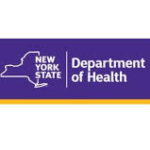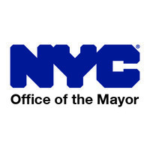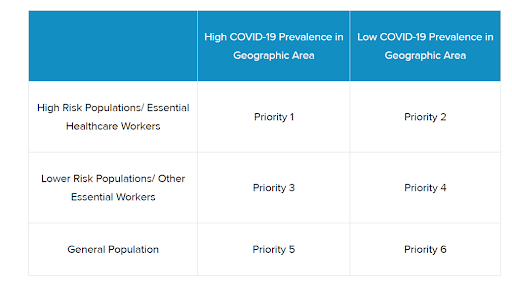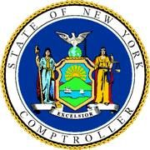In the News – State
 New York State COVID-19 Vaccination Administration Program
New York State COVID-19 Vaccination Administration Program
NYS Department of Health released a Draft COVID-19 Vaccination Administration Program that serves as an initial framework for distribution of a COVID-19 vaccine in New York.
The program was developed in consultation with clinical and public health experts and requires collaboration with local health departments, community organizations, and the federal government.
As the vaccine development process progresses, the draft New York State Program is designed to account for multiple variables and scenarios regarding vaccine availability, timeline for vaccine approval, federal and state responsibilities, funding, supply chain needs, and allocation requirements.
New York’s program includes a proposed prioritization matrix to ensure those most at risk and essential workers are priority recipients, with particular attention paid to those living in communities with highest the COVID prevalence.
Within each phase, the draft plan puts forward the following proposed additional prioritization phases to be used based on vaccine availability and vaccination rates:
Phase 1
- Healthcare workers (clinical and non-clinical) in patient care settings (ICU, ED, EMS top priority)
- Long-term care facility workers who regularly interact with residents
- Most at-risk long-term care facility patients
Phase 2
- First responders (fire, police, national guard)
- Teachers/school staff (in-person instructions), childcare providers
- Public Health workers
- Other essential frontline workers that regularly interact with public (pharmacists, grocery store workers, transit employees, etc.) or maintain critical infrastructure
- Other long-term care facility patients and those living in other congregate settings
- Individuals in general population deemed particularly high risk due to comorbidities and health conditions
Phase 3
- Individuals over 65
- Individuals under 65 with high-risk
Phase 4
- All other essential workers
Phase 5
- Healthy adults and children
The 96-page draft plan is subject to change based on future details expected from the federal government. It outlines:
- Measures to ensure vaccine safety and effectiveness, both pre and post administration.
- Expertise to guide vaccine distribution and implementation.
- A vaccine prioritization matrix based on clinical guidance.
- A process for efficient vaccine distribution and delivery.
- Measures to train, register, deploy, and support providers to administer the vaccine.
- A data and IT infrastructure to coordinate and monitor all aspects of the vaccine program.
- A public education and community outreach campaign to build trust and inform the public.
- A Vaccine Central Command Center to manage the entire vaccine program.
- A budget and procurement process to obtain necessary supplies and equipment.
In the News – City
 City Releases Initial COVID-19 Vaccine Framework
City Releases Initial COVID-19 Vaccine Framework
Working with the State, the de Blasio Administration this week announced an initial COVID-19 vaccine framework to guarantee maximum distribution of a “safe, effective, and free vaccine,” with an emphasis on communities hardest hit by the pandemic.
Over the next two months, the City will engage public health stakeholders and community groups across the city’s hospitals, clinics, Federally Qualified Health Centers (FQHC’s), independent pharmacies, urgent cares, and independent providers to ensure access to a vaccine citywide.
Phase one of distribution—to be available as early as November—will provide a limited number of doses primarily reserved for healthcare personnel, frontline workers, and other vulnerable groups. To prepare for this initial rollout, the City is actively enrolling providers in the Department of Health and Mental Hygiene’s Citywide Immunization Registry, focusing first on hospitals and then on FQHCs.
Over 2,500 providers are currently reporting to the Registry. Through webinars and meetings, DOHMH will continue to educate providers about vaccine availability, likely priority groups, proper storage, and how to order, receive, administer, allocate, and report on the vaccine.
Phase two of distribution, which could occur as early as 2021, will see more widespread availability for the general public. To meet this increased availability, the City will ensure that there is adequate storage and capacity.
The City will continue to recruit and prepare community providers, including FQHCs, pharmacies, urgent care, hospitals, NYC Health + Hospitals, DOHMH COVID-19 testing sites, and community vaccinators.
Vaccine uptake will be closely and consistently tracked through the Citywide Immunization Registry, with results reported out to the public on a periodic basis. The City will also monitor for serious, adverse effects and educate providers on how to report on them. Additionally, the City will conduct its own vaccine effectiveness studies and continually follow up with a sample of New Yorkers who receive a vaccine.
Amidst the economic tumult brought on by the COVID-19 pandemic, the securities industry saw its pretax profits reach $27.6 billion in the first six months of 2020, an 82 percent increase over the same period last year, according to State Comptroller Thomas DiNapoli’s annual report on Wall St.’s performance.
Industry performance is traditionally measured by the pretax profits of the broker/dealer operations of New York Stock Exchange (NYSE) member firms. There are now about 120 member firms.
First half profits in 2020 were nearly equal to 2019’s total profits of $28.1 billion. The jump was propelled by $2.4 trillion in federal stimulus funds and the lowering of interest rates. In addition, market swings drove trading volume upward along with firms’ commissions and trading income. Firms’ income from underwriting rose by more than one-third in the first half of 2020 over the same period last year.
According to the Comptroller, while continued profit growth in the second half remains to be seen, 2020 profits are on pace to surpass last year.
Other findings included in the report are:
- Employment: In 2019, the securities industry was at its highest employment level since the 2008 financial crisis with 182,100 jobs. This year, Wall Street is on pace to shed 7,300 jobs, erasing nearly half (45 percent) of the jobs gained since 2013.
- Salary: The average salary, including bonuses, for industry employees in New York City was $406,854 in 2019, an increase of 2 percent compared to 2018. It is nearly five times more than the $82,938 average salary for the rest of the private sector in the city in 2019.
- Bonuses: The average bonus paid in the industry for 2019 was $164,100, up 3 percent from 2018, and in line with last year’s increased profits. In the first half of 2020, firms have set aside nearly 5 percent more for compensation than last year. According to the Comptroller, the size of 2020 bonuses will heavily depend on the resumption of broad economic activity in the second half of the year, as well as associated loan performance. The city has forecast a one-third (34 percent) decline in bonuses this year. The state Division of the Budget has projected a decline in finance and insurance bonuses of 28 percent as part of the state’s first quarter financial plan update.
- Economic Impact: State and city economic impact from the securities industry has also lessened. The industry is the largest single contributor to the city’s economy, responsible for 17 percent of all economic activity in 2018. Wall St.’s share of state economic activity was 5.9 percent in 2019.Wall St. accounts for 18 percent ($15.1 billion) of all tax collections in state fiscal year ending March 30, 2020. The industry’s estimated contribution of $3.9 billion to the city’s total tax collections in its fiscal year ending June 30, 2020, was down 5 percent from the previous year, reflecting a decline in jobs and capital gains. Wall St.’s share of city tax revenue has declined over the past several years as the city’s economy has diversified.
 Mayor Bill de Blasio this week appointed Melanie Hartzog as Deputy Mayor for Health and Human Services and Jacques Jiha as Director of the Mayor’s Office of Management and Budget.
Mayor Bill de Blasio this week appointed Melanie Hartzog as Deputy Mayor for Health and Human Services and Jacques Jiha as Director of the Mayor’s Office of Management and Budget.
Hartzog previously served as Budget Director and Jiha served as the Commissioner for the New York City Department of Finance.
Before joining the Office of Management and Budget, Hartzog served as Executive Director of the Children’s Defense Fund. Previously, she served as Family Services Coordinator for the Deputy Mayor for Health and Human Services and Deputy Commissioner of the Administration for Children’s Services. She also led a social services unit in the Mayor’s Office of Management and Budget, and was Director of Policy and Advocacy for the Human Services Council of New York City, Inc.
Hartzog holds a Master of Science degree from the New School’s Milano School of International Affairs, Management and Urban Policy and Bachelor of Arts from Eckerd College. She lives in Brooklyn with her husband and three children.
Prior to becoming commissioner of the Department of Finance, Dr. Jiha was the chief operating officer and chief financial officer of Earl G. Graves, Ltd/Black Enterprise. Previously, he served as deputy comptroller for pension investment and public finance in the Office of the New York State Comptroller, deputy comptroller for Nassau County, chief economist for the New York City Office of the Comptroller, executive director of the New York State Legislative Tax Study Commission, and principal economist for the New York State Assembly Committee on Ways and Means.
Born in Haiti, Dr. Jiha immigrated to New York City in 1979 and earned his bachelor’s degree in economics from Fordham University. He also holds a Ph.D. and a master’s degree in economics from the New School for Social Research. He lives in Queens with his wife and daughters.
Briefs
Governor Cuomo Signs Executive Order Extending Moratorium On COVID-Related Commercial Evictions Through January 1
Governor Andrew Cuomo this week signed an Executive Order extending the state’s moratorium on COVID-related commercial evictions and foreclosures through January 1. This measure extends protections already in place for commercial tenants and mortgagors.
According to the Governor, the extension gives commercial tenants and mortgagors additional time to catch up on rent or their mortgage, or to renegotiate their lease terms to avoid foreclosure moving forward.
New York Ski Resorts Allowed to Reopen With 50 Percent Indoor Capacity Beginning November 6
New York ski resorts can reopen with 50 percent indoor capacity and with strict health and safety protocols under state-issued guidance starting Friday, November 6, according to Governor Andrew Cuomo.
State guidance on the reopening of ski resorts includes the following precautions:
- Masks required at all times, except when eating/drinking or skiing.
- Social distancing between parties required at all times.
- Restrict gondolas/lifts to members of the same party.
- Limit ski lessons to no more than 10 people.
- Thorough cleaning and disinfection of shared/rented equipment.
- Shuttles, food & beverage, retail service must conform to State-issued guidance.
- Reduce outdoor capacity on mountain by 25% during “peak” days or if multiple trails are closed due to unseasonable conditions.
Most Movie Theaters Outside of New York City Can Reopen
Movie theaters outside of New York City can reopen at 25 percent capacity under state guidance starting today, October 23 No more than 50 people are allowed in front of each screen in each movie theater at once.
Theaters can only open outside of New York City in counties that have COVID-19 positivity rates of less than 2 percent on a 14-day average and do not have any cluster zones. Theaters will be subject to rigorous state guidance and enforcement, according to Governor Andrew Cuomo.
City Triples Estimate Of NYCHA Apartments With Lead Risk To Children
The number of children potentially exposed to lead paint in New York City’s public housing buildings is three times greater than previously thought, according to the federal monitor charged with overseeing New York City Housing Authority (NYCHA).
According to a statement released by federal monitor Bart Schwartz on his website NYCHAMonitor.com, approximately 6,000 additional apartments with children under the age of six are believed to contain lead paint. An annual certification made two years ago identified 3,000 units.
“NYCHA reported to us this week that as a result of its dialogue with residents during in apartment XRF testing visits, and NYCHA’s ‘door knocking’ campaign, through which NYCHA directly engages residents, it has identified a significantly larger number of apartments where children under six reside who might be exposed to lead risks,” Schwartz said. “…Now, of course, the job is to ensure that the children are protected from lead risks. NYCHA already has undertaken numerous steps in that direction. With this new information, the importance of quickly and thoroughly implementing all necessary actions must be emphasized.”
Mayor de Blasio Announces City Will Advance Funding for Housing New York Plan
Mayor Bill de Blasio this week announced the acceleration of capital funding within the City’s affordable housing plan. The City will return $466 million to the current fiscal year’s capital budget during the upcoming Preliminary Plan to address urgent affordable housing needs.
The Housing New York goal of creating and preserving 300,000 affordable homes by 2026 remains on track. With the reallocation, the capital investment this fiscal year increases to over $1.4 billion.
In March, the City moved $466 million from HPD’s Fiscal Year 2021 capital budget into Fiscal Years 2022 through 2024. The City will be moving these funds back to Fiscal Year 2021.
Also this week, New York City released the Where We Live NYC Plan, the City’s blueprint for fair housing in the five boroughs.
New York State Rescinds Proposal to Allow Non-Lawyers to Oversee Special Education Complaints in New York City
State Education Department officials pulled a controversial proposal that would have allowed non-lawyers to oversee special education complaints in New York City.
The proposal was part of a series of potential regulatory changes meant to speed up the resolution of New York City’s special education cases. During the 2019-2020 school year, the city fielded 10,797 complaints, accounting for 96% of complaints logged across New York, according to the state. Cases are required by law to be resolved within 75 days, but as of last school year, cases were resolved in 259 days on average in New York City.
Election Day, November 3rd
Electronic Request for an Absentee Ballot
(Online request must be made by October 27, 2020. Please be advised that despite this deadline, the Post Office has advised they cannot guarantee timely delivery of ballots applied for less than 15 days before an election).
Early Voting Starts Tomorrow
The Early Voting period for the November General Election will be October 24, 2020- November 1, 2020. Registered voters can use the Voter Registration and Poll Search Site to Find the Early Voting Sites in Their Counties.
New York State Voting Leave Rights
Employees in New York State are eligible for up to two hours of paid time off to vote if they do not have “sufficient time to vote.” An employee is deemed to have “sufficient time to vote” if an employee has four consecutive hours to vote either from the opening of the polls to the beginning of their work shift, or four consecutive hours between the end of a working shift and the closing of the polls.
An employee must notify an employer at least two working days prior to their intention to take paid time off to vote, but not more than ten working days.
Coming Up
New York State
No hearings scheduled.
New York City
Monday, October 26th
Committee on Environmental Protection, Remote Hearing (Virtual Room 1), 11 a.m.
Tuesday, October 27th
Committee on Transportation, Remote Hearing (Virtual Room 3), 10 a.m.
Committee on Resiliency and Waterfronts, Remote Hearing (Virtual Room 1), 11 a.m. Oversight – 8th Anniversary of Superstorm Sandy and the 2020 Hurricane Season
Wednesday, October 28th
Committee on Health & Women and Gender Equity, Remote Hearing (Virtual Room 1), 10 a.m.
Committee on General Welfare, Remote Hearing (Virtual Room 2), 1 p.m. Oversight – Racial Disparities in the Child Welfare System
Thursday, October 29th
Committee on Rules, Privileges and Elections, Remote Hearing (Virtual Room 1), 11 a.m.
Stated Council Meeting, Remote Hearing (Virtual Room 1), 1:30 p.m. Friday, October 30th
Committee on Aging, Remote Hearing (Virtual Room 2), 10 a.m.
Committee on Technology & Small Business, Remote Hearing (Virtual Room 1), 1 p.m.


